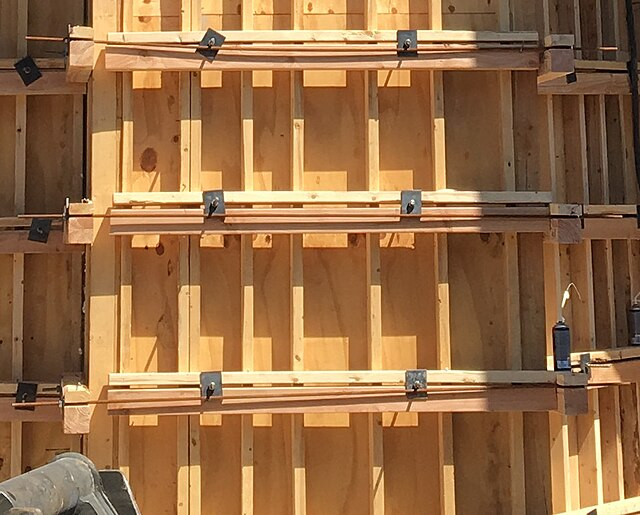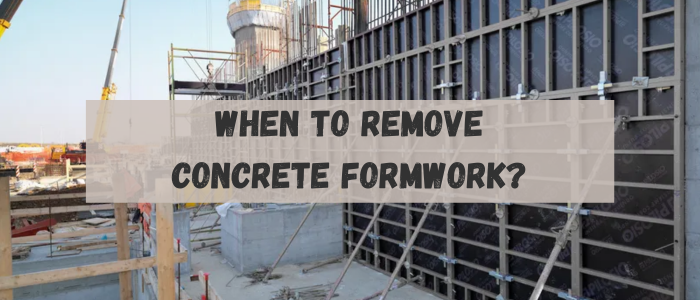In this article, we discuss the appropriate time to remove the formwork after casting concrete. Concrete formwork removal, also known as strike-off or stripping of formwork, should only be done after the concrete has strengthened enough to withstand at least twice the amount of stress that it could experience during formwork removal. When removing formwork, it’s equally important to make sure the existing formwork is stable.

So, what is a suitable time for removing the formwork of concrete?
When to Remove Concrete Forms?
The concrete hardening rate and strength are influenced by temperature, impacting the time for formwork removal. For instance, the duration for removing concrete in colder conditions will exceed that required in warmer seasons. Paying special attention is crucial when removing formwork from flexural members like beams and slabs. These members bear both self-load and live load during construction, and insufficient strength may lead to deflection.
To assess concrete strength before formwork removal, conduct tests on concrete cubes or cylinders. These specimens should be made from the same mix as the structural members and cured under identical temperature and moisture conditions. Formwork removal should only occur once it is confirmed that the concrete in structural members has attained adequate strength to withstand the design load. If possible, leaving the formworks in place for an extended period aids in curing.
Keep in mind that removal of formwork should not lead to the following issues with the structural element:
- Avoid causing the structural element to collapse under self-load or the designated design load.
- Prevent excessive deflection of the structural member, both in the short and long term.
- Take precautions to ensure that the removal of formwork does not result in physical damage to the structural member.
Additionally, during formwork removal, consider whether the structure might be susceptible to: Freeze-thaw damage and formation of cracks due to thermal contraction of concrete after formwork striking. If there is a notable risk of any of the mentioned damages, it is advisable to postpone the formwork removal to mitigate potential issues. If there’s a necessity to remove the formwork for optimizing concrete construction activities, it is crucial to ensure proper insulation of these structures to prevent such damages.
How to Calculate Safe Time to Remove Formwork?
Structural members are initially built based on the designed load, but during the construction process, they experience their self-weight and construction loads before being subjected to the full range of loads assumed in the structural design. To expedite construction activities, it is crucial to assess the behavior of the structure under its self-load and construction load. If this analysis confirms the structural member’s safety, formwork removal can proceed.
However, if detailed calculations are not feasible, the following formula can be employed to calculate safe formwork striking times:
Characteristic strength of cube = Strength at the required maturity for the structure at the time of formwork removal
This equation assists in establishing the appropriate time for formwork removal, relying on the characteristic strength of a cube that has reached maturity matching the structural needs at the moment of formwork removal.
We can also use non-destructive tests to determine the strength of concrete.
Factors affecting Time to Remove Formwork?
The time for removing concrete formwork is influenced by the strength of the structural member, which, in turn, depends on various factors affecting the development of concrete strength:
Grade of concrete: A higher concrete grade results in a faster rate of strength development, allowing the concrete to achieve its strength in a shorter timeframe.
Grade of cement: The use of higher-grade cement contributes to quicker strength attainment in concrete.
Type of Cement: The type of cement utilized has an impact on concrete strength development. For instance, rapid hardening cement exhibits higher strength gain within a shorter period compared to Ordinary Portland Cement (OPC). Conversely, low heat cement requires more time to reach sufficient strength than OPC.
Temperature: Elevated concrete temperature during placement accelerates strength development, leading to quicker attainment of strength. In contrast, colder temperatures, especially during winter, prolong the time required for concrete strength gain.
Ambient temperature: Higher ambient temperatures facilitate faster strength gain in concrete.
Formwork insulation: Formwork serves to insulate concrete from its surroundings. The longer the formwork remains in contact with the concrete, the less heat of hydration is lost, resulting in a higher rate of strength gain.
Size of the concrete member: Larger concrete section members generally gain strength more rapidly than smaller sections.
Accelerated curing: The application of heat in accelerated curing is a method employed to increase the rate of strength gain in concrete.
Generally, the following values for strength and time are guidelines for removing the formwork.
Strength of concrete required for removing formwork according to element type and span.
| Concrete Strength | Structural Member Type and Span |
| 2.5 MPa | Lateral parts of the formwork for all structural members can be removed |
| 70% of design strength | Interior parts of formwork of slabs and beams with a span <= 6m can be removed |
| 85% of design strength | Interior parts of formwork of slabs and beams with a span of > 6m can be removed |
Time for removing formwork for various elements.
| Type of Formwork | Formwork Removal Time |
| Sides of Walls, Columns and Vertical faces of beam | 24 h to 48 h (the engineer decides) |
| Slabs (props left under) | 3 days |
| Beam soffits (props left under) | 7 days |
| Removal of Props of Slabs: | |
| i) Slabs spanning up to 4.5m | 14 days |
| ii) Slabs spanning over 4.5m | 14 days |
| Removal of props for beams and arches | |
| i) Span up to 6m | 14 days |
| ii) Span over 6m | 21 days |
Keep in mind:
It is crucial to highlight that the indicated formwork removal times are specifically applicable when Ordinary Portland Cement is used. In standard construction procedures, Portland Pozzolana cement is the common choice. Therefore, the provided times need adjustments.
For cements other than Ordinary Portland Cement, the formwork removal times should be modified as follows:
- Portland Pozzolana Cement: The stripping time will be 10/7 of the originally stated time.
- Low Heat Cement: The stripping time will also be 10/7 of the initially mentioned time.
- For Rapid Hardening Cement, a stripping time of 3/7 of the initially mentioned time is generally sufficient. However, for vertical sides of slabs, beams, and columns, it is recommended to retain the formwork for at least 24 hours.
Read Also:

